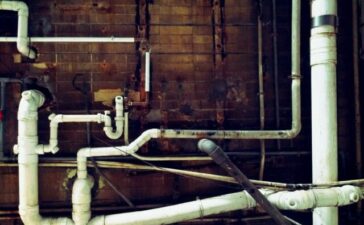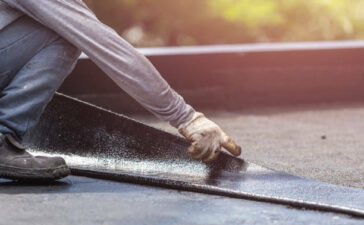The roof of your home is among the most integral parts of the house. It protects you and your loved ones from harsh weather and external threats. And it’s arguably the most exposed part of our house, so it is more prone to wear and tear and deterioration.
Your roof requires consistent maintenance and repairs and checking in now and then to ensure that everything runs smoothly. As per the National Roofing Contractors Association, homeowners are advised to inspect their roofs at least twice a year, especially in spring and fall. Being proactive in your approach to handling your rooftop and consistently looking out for specific indicators that represent the health of your roof can help you minimize repair costs and property damage. Here are a few indications that your roof might need certain repairs or complete replacement:
1. Water Damage in Attic
Any marks that represent some form of water damage on your ceiling represent a fault in your roof. These marks can include moisture marks or brown and yellow stains, as well as peeling paint on walls. These all indicate a damaged rooftop and need for instant repairs. You need to closely observe your attic as well, as any leaks there also represent immense roof damage. If you are skeptical about water damage, it might be a good idea to call a roofer for a professional inspection. A simple check can help you save thousands of dollars in roof replacement as the damage will deteriorate and keep getting costlier to fix if you ignore it. A professional will have adequate knowledge and tools to ensure the proper analysis of the condition of your roof and prevent it from worsening.
2. Sagging
Roof sagging is another indication that your roof may be in dire need of some changes. The sagging roof shows that some moisture content has been trapped in the roof and has rotted away boards under the roof. A sagging roof carries the potential harm of hurting your loved ones and not being able to provide sufficient protection from the external environment. It is vital to check even the lowest layer of your roof as any moisture can also be trapped there. You can check your roof by standing across your house and examining different angles. Your roof should appear straight along its lines, and any kinked or curved lines will indicate damage.
3. Moss, or Mold Formation
Any form of moss, mold, and fungi forming on your roof indicates that your roof needs repairs. These suggest some trapped moisture in your roof and maybe even rotting boards, which will ruin a roof severely. You can use a stiff brush to remove moss from the corners. If the moss is challenging to get rid of, it may be more suitable to contact a professional to get the roof adequately inspected to figure out the cause.
4. Curling or Buckling Shingles
If your roof shingles have started to curl up, it shows that your shingles are no longer properly attached. This can be a result of some damage due to external factors. However, damaged shingles or curved surfaces can lead to further damage when the weather gets harsh the next time. In such cases, it is advised to contact a roof repair company immediately. It is crucial to thoroughly research all the repair companies in your area and choose one that has experts who can replace specific shingles and identify any potential damage they may have caused.
5. Missing Parts
In regions that experience extreme weather conditions, roofs can get strained by intense thunderstorms or snow. High winds cause roof shingles to fly off completely or be damaged due to drastic weather changes. If one or two shingles are missing, it may not be as big of a problem initially. However, missing granules or shingles can cause potential harm depending on the location of that missing shingle.
6. Missing Flashing or Gutter Guards
If your rooftop is missing the structure that supports it, you need to fix it as soon as you can. Your roof needs adequate support, as otherwise, it will constantly be at the risk of falling. Missing gutter guards or flashing represent poor structure and no proper drainage system. This means that your roof is on the verge of collapse at any given moment.
7. Significant Energy Bills
Heating and cooling can be pretty expensive across all states. A good, working roof can help keep the cool air inside, significantly reducing the cooling bills in warmer regions. This works similarly for cooler areas as well, which require less heating when their roof is in good shape. If your heating or cooling bills have been more expensive than your neighbors’ regular charges, it may indicate a problem with your roof. Everything from moisture to old material or leaks can cause this problem. In such situations, it is advised to call a professional for an inspection of your roof.
8. The Roof Is Past Its Lifespan
The average lifespan of a roof is somewhere between 20 and 50 years, but it can change with the type of roofing material used in your ceiling. In warmer regions, asphalt shingles can last somewhere between 10 to 20 years, while metal roofs can be a bit more expensive but last longer, with an average lifespan of 30 to 50 years. In warmer regions, clay tiles also last around 40 years. You need to keep in mind the installation dates of your rooftop to ensure that your rooftop is not past its lifespan. It is also essential to know if your roof was installed over the layer of an old one, as that can weaken and shorten the overall lifespan.
9. Frequent Need For Inspection
If you have been inspecting your roof yourself and you now require professional inspection, your roof may be going through more severe damage than you expected. The need to call a roofing inspector indicates that your roof requires several repairs and maybe a replacement of one layer.
Endnote
If your roof has been showing signs of any potential damage from curling shingles, water leakage, or sagging, it may be the right time to contact a professional service that repairs or replaces roofs in your locality. You can look up Niagara Roof Masters for their expert services in this industry and their extensive experience in helping clients overcome challenges by identifying their roofs’ problems and reaching a sustainable solution.






